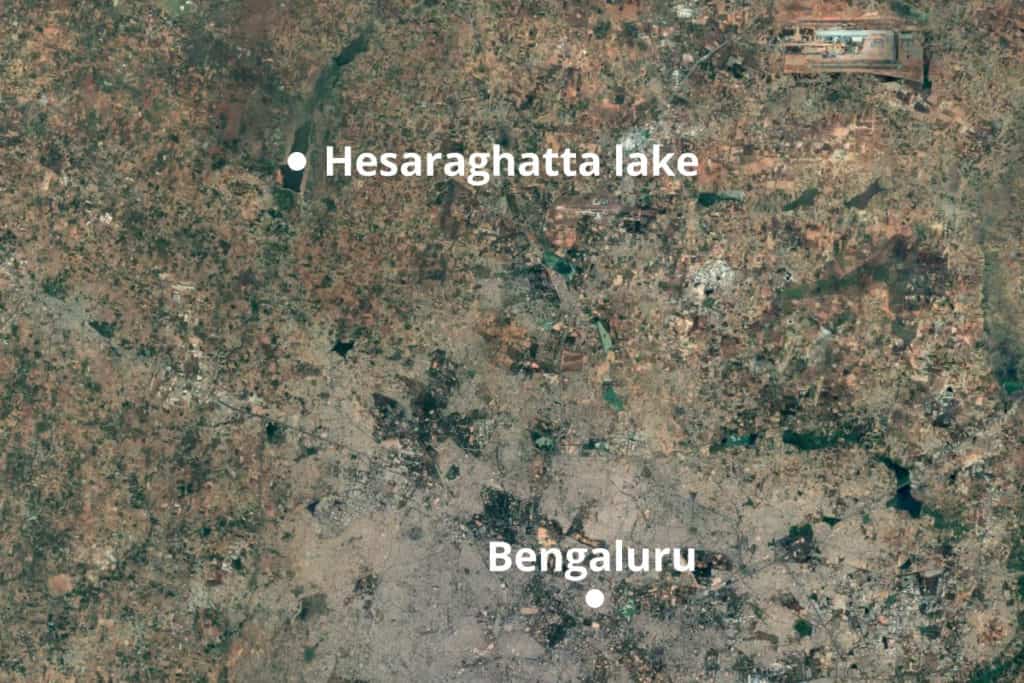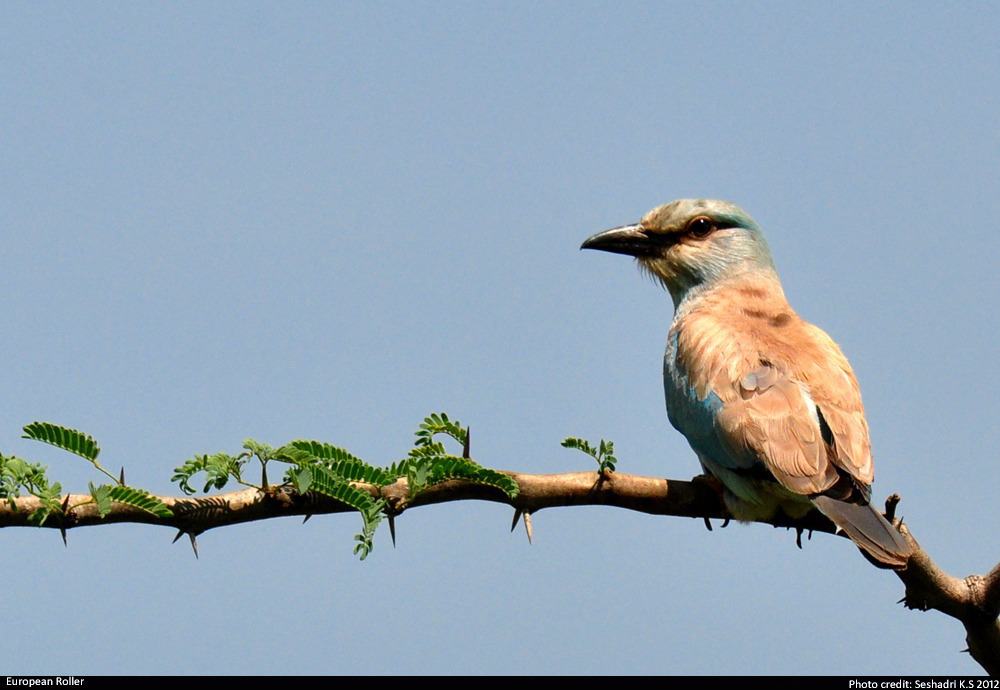To a mind that’s taught to see vast swathes of land where no large trees but “mere” grass and shrubs grow as inconsequential, Hesaraghatta’s distinction as a unique habitat for flora and fauna may come as a rude shock. Here, the view is just grass, with a few trees to break the monotony, a dying river skirting the landscape, and a man made lake dependent on annual monsoons to validate its worth.
So, to truly appreciate the biodiversity hotspot that Hesaraghatta is, you have to either look up at the sky or peer hard into the ground.
Around 235 species of birds, some of them listed as endangered or vulnerable on the IUCN Red List, glide across the sky. A whopping 400 species of insects, of which nearly 30 have been described as new to science by entomologists, and 100 species of butterflies including the very rare Lilac Silverline (Cigaritis lilacinus), have chosen this land as their breeding spot.
Located about 30 km to the north-west of Bengaluru, Hesaraghatta lakebed spans an area of about 1912 acres (744 ha) and is essentially dry during most part of the year. It is fully dependent on rainfall for its water. The 356 acres of landscape surrounding the lakebed is the last remaining grassland habitat in the Bengaluru region.

Hesaraghatta tank is one of the two major water reservoirs of the Arkavathy river. Originating in the Nandi Hills, the river Arkavathy was once an important source of water for Bengaluru before the city switched to river Cauvery for its water needs. Arkavathy river feeds a series of cascading tanks including Hesaraghatta.
Hesaraghatta tank was mostly neglected until the Yettinahole river diversion project caught the fancy of the Karnataka government. The project proposes to divert 24 TMC (thousand million cubic feet) of water from streams like Yettinahole, Kadumanehole, Kerihole and Hongadahalla, originating in the upper reaches of Western Ghats, to drought-prone areas of the state like Kolar and rural Bengaluru. As part of the project, lakes like Hesaraghatta would be augmented to provide water to rural Bengaluru. As usual, Hesaraghatta was back in the news with yet another project to make the land “economically viable”.
Unique landscape hosting exceptional biodiversity
The grassland surrounding the lakebed supports unique biodiversity. A paper published in 2013 suggests that the lakebed vegetation is in transition. “From being a true aquatic community, the vegetation in the lakebed is undergoing a process of ‘ecological succession’ and is currently a grassland-savannah-woodland complex,” says the paper.
K S Gopi Sundar, a scientist at Nature Conservation Foundation and the global co-chair of the IUCN Stork, Ibis, and Spoonbill Specialist Group, says that Hesaraghatta is a unique system of freshwater wetland-grassland-marshland which is critically endangered around the world. “It is an open, semi-wet system which is incredibly productive. These systems attract insects in large numbers which in turn attract birds and reptiles. These pockets of habitats in an urban setting help maintain local biodiversity,” he says.
Dr S Subramanya, a former faculty at the University of Agricultural Sciences, Bengaluru, who has been studying birds over the past 40 years, has documented various groups of plants and animals inhabiting the Hesaraghatta grasslands. He says it is one of the best biodiversity hotspots in Bengaluru, with a number of threatened species under IUCN threat categories as well as Schedule I and II of the Wildlife Protection Act of India.

In 2011, the Lesser Florican, an endangered bird species, was rediscovered in Bengaluru after 100 years, at Hesaraghatta. Of the 235 bird species recorded from the area, around 35% are migrants, mostly from Central Asia and the Himalayas that come here to spend the winter, Subramanya says. “In addition, 55 species of plants, 10 species of wild mammals, seven species of reptiles and 13 species of frogs and toads, and over 100 butterflies have been identified here,” he says.
If the arrival of the Lesser Florican, a Schedule I species under the Wildlife (Protection) Act 1972, in the grassland created a flutter a decade ago, sightings of rare birds like the Egyptian Vulture, Steppe Eagle, Spotted Eagles, and the amphibian Sholiga narrow-mouthed frog are no less remarkable. Another Schedule I species, the leopard has been sighted here, in addition to mammals like jackals, Indian fox and Slender Loris.
Hesaraghatta is also known for one of the largest roosting populations of migrant harriers in Karnataka, says Dr Subramanya. Gopi Sundar says raptors or birds of prey are apex predators among avifauna, and that their population is on the decline around the world. “At Hesaraghatta, however, you see birds of prey like harriers, eagles, falcons, etc in large numbers,” he says.
Dr Yeshwanth H M, an entomologist at the University of Agricultural Sciences, says rare bugs like Sulawesifulvius belonging to the genus of Mirid plant-bug were identified in Hesaraghatta in 2015. It was only seen in Sulawesi, Indonesia in 2004 and later in China in 2014, before here at Hessarghatta, he informs. In 2012, the Lilac Silverline butterfly, which was thought to be extinct, was rediscovered after a gap of nearly 120 years in the Hessarghatta area.
Human activities destroy vegetation, habitat
Despite its ecological importance, Hesaraghatta lacks the protection it deserves. If that was not bad enough, this piece of pristine land constantly faces various threats – from weekend trippers who litter the place, to over-enthusiastic bird photographers who chase birds on four-wheelers, not to mention land grabbers who want to “develop” the vacant land to monetise it.

In 2011, the Bangalore Development Authority (BDA), as a part of their Namma Hasiru Maale (Our Green Garland) programme, planted around one lakh tree saplings at Rs 140 per sapling. “Within two years, 90% of the saplings perished,” says Mahesh Bhat, photographer, environmentalist and resident of Hesaraghatta, who is also a member of the Arkavathy Kumudvathy River Rejuvenation Trust.
He says that most of the saplings were burnt during occasional fires in the dry season. “Just a handful of the 100,000 saplings have taken root. But carbon emitted through all the digging, transporting of saplings over long distances, tractors used for watering will never be neutralised,” he says.
Hesaraghatta was, till sometime ago, a favoured destination of bird photographers who, according to a study done in 2013, chase birds on four-wheelers for a better chance at photographing them, thereby trampling on the vegetation and destroying the grassland.
As per the study, a total of 71 four-wheelers (cars and SUVs), a three-wheeler and six two-wheelers were spotted within four days, which translated to an average of 20 vehicles per day. The highest number of four wheelers, 26, was counted on a day that a rare bird, the European Roller Coracias garrulus, listed as ‘vulnerable’ on the IUCN Red List, was sighted.

The paper suggests that trampling leads to changes in vegetation composition and structure. “Off-road driving causes extensive crushing of vegetation. It has been estimated that a standard car on hard ground exerts 1500 g/cm2 of pressure as compared to 206 g/cm2 for an average-sized human male or 160 g/cm2 for an average-sized human female walking on hard ground. Apart from affecting vegetation, trampling and driving also destroy the nests of ground-nesting birds like skylarks, pipits, and lapwings, to name a few,” says the study.
What lies ahead for the grasslands?
In 2014, Mahesh Bhat, along with conservationist Ramki Srinivasan, biologist K S Sheshadri and ornithologist M B Krishna, submitted a detailed proposal to the Karnataka Forest Department to declare 5000 acres of Hesaraghatta land including the lakebed as a ‘conservation reserve’ under section 36A of the Wildlife Protection Act. The proposal is now awaiting the State Wildlife Board’s approval.
Meanwhile, the state government seems to have a completely different plan charted out for Hesaraghatta. Once a preferred destination for Kannada movie-makers, the state government plans to build a film city in a 150-acre plot in Hesaraghatta. This plan was mooted 30 years ago by former Chief Minister Ramakrishna Hegde and has been on and off the table.
In the proposal to declare it as ‘Greater Hesaraghatta Conservation Reserve’, Mahesh and others say that the Hesaraghatta grasslands and surrounding areas rich are under pressure from various human activities that are bound to increase if any conservation intervention is delayed. They believe a film city here will sound the death knell to the grasslands, and Bengaluru city will lose one of its pristine, ecologically important habitats forever.
[This article is part of a series on ‘Bengaluru’s Ecosystems and Biodiversity’. This is a joint project with Mongabay India, and is supported by the Bengaluru Sustainability Forum]
Grasslands are not wastelands. They support diverse species of insects, butterflies and birds depend for food on insects and grains from these grasslands.
Why film city in bangalore
We already have one on mysore road let them redevelop it and go for some remote area for the film city so as even tourism increases beyond Bangalore we have sufficient crowding and tourist spots in bangalore and dont need more of it. Request BDA to look into other nearby city may be historical city where the mughal time destroyed palace and temples can be rebuilt like helebedure and other development happen so as we serve uniqueness to film industry for coming to karnataka instead of copying what Hyderabad has or UP is planning.
Karnataka has advantage of nature with heritage bangalore to hasan is a good stretch of mix of two.
Please secure Hesaraghatta lake include Grass land by summer fire & weekend trippers. Hesaraghatta Gramapanchayat staff thrown their collected waste to Hesaraghatta lake bank area.